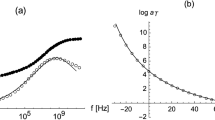Abstract
AMONTONS'S classical law of friction, as explained by the cohesion theory, accounts satisfactorily for most cases of metallic friction. For non-metallic materials, however, and in particular the elastic solid field of polymeric monofilaments and natural fibrous materials, many exceptions to his law have been reported1–4. In these cases it has been observed that over an appreciable load range, the frictional coefficient (µ) does not remain a constant but decreases as the load increases, which suggests that local deformation occurs at the interface between the polymer and friction object. To explain the variability of µ, it has been proposed5 that the true area of contact and the shear strength vary with the load. For this to be true, Howell6,7 has shown that the frictional force must be related to the load by F = KWn, where K and n are constants. (The value of K depends on the properties of the surface materials while n is independent of these and is dependent only on the mechanism of deformation, that is, n is an indicator of the visco-elastic properties of the material under test.) For a fibre or a yarn travelling at a constant speed over a cylindrical object, the change in tension developed in the fibre or yarn is therefore found from the following equation  where T2 and T1 are the output and input tensions, respectively, θ is the angle of yarn wrap, and R is the radius of curvature of the test object.
where T2 and T1 are the output and input tensions, respectively, θ is the angle of yarn wrap, and R is the radius of curvature of the test object.
This is a preview of subscription content, access via your institution
Access options
Subscribe to this journal
Receive 51 print issues and online access
$199.00 per year
only $3.90 per issue
Buy this article
- Purchase on Springer Link
- Instant access to full article PDF
Prices may be subject to local taxes which are calculated during checkout
Similar content being viewed by others
References
Bowden, F. P., and Young, J. E., Proc. Roy. Soc., A, 208, 444 (1951).
Howell, H. G., and Mazur, J., J. Textile Inst., 44, T59 (1953).
Lincoln, B., Brit. J. App. Phys., 3, 260 (1952).
Schallawach, A., Proc. Phys. Soc. B, 65, 657 (1952).
Lodge, A. S., and Howell, H. G., Proc. Phys. Soc., B, 67, 89 (1954).
Howell, H. G., J. Textile Inst., 44, T359 (1953).
Howell, H. G., J. Textile Inst., 45, T575 (1954).
Knapton, J. J. F., Rev. Sci. Instrum., 37, 197 (1966).
Rubenstein, C., J. Textile Inst., 49, T13 (1958).
Bowden, F. P., and Tabor, D., The Friction and Lubrication of Solids Pt. 2, 220 (Oxford Univ. Press, 1964).
Howell, H. G., Mieszkis, K. W., and Tabor, D., Friction in Textiles, 49 (Butterworths, Ltd.London, 1959).
Moss, E., Brit. J. App. Phys., suppl. No. 1, 19 (1951).
Howell, H. G., Mieszkis, K. W., and Tabor, D., Friction in Textiles, 34 (Butterworths, Ltd., London, 1959).
Whitney, J. M., Textile Res. J., 35, 281 (1965), and U.S. Air Force Report No. RTD-TDR-63-4127 (1963).
Gralén, N., Proc. Roy. Soc. A, 212, 491 (1952).
Author information
Authors and Affiliations
Rights and permissions
About this article
Cite this article
KNAPTON, J. Characteristics of Fibre Friction. Nature 213, 898–899 (1967). https://doi.org/10.1038/213898b0
Received:
Published:
Issue Date:
DOI: https://doi.org/10.1038/213898b0
Comments
By submitting a comment you agree to abide by our Terms and Community Guidelines. If you find something abusive or that does not comply with our terms or guidelines please flag it as inappropriate.



